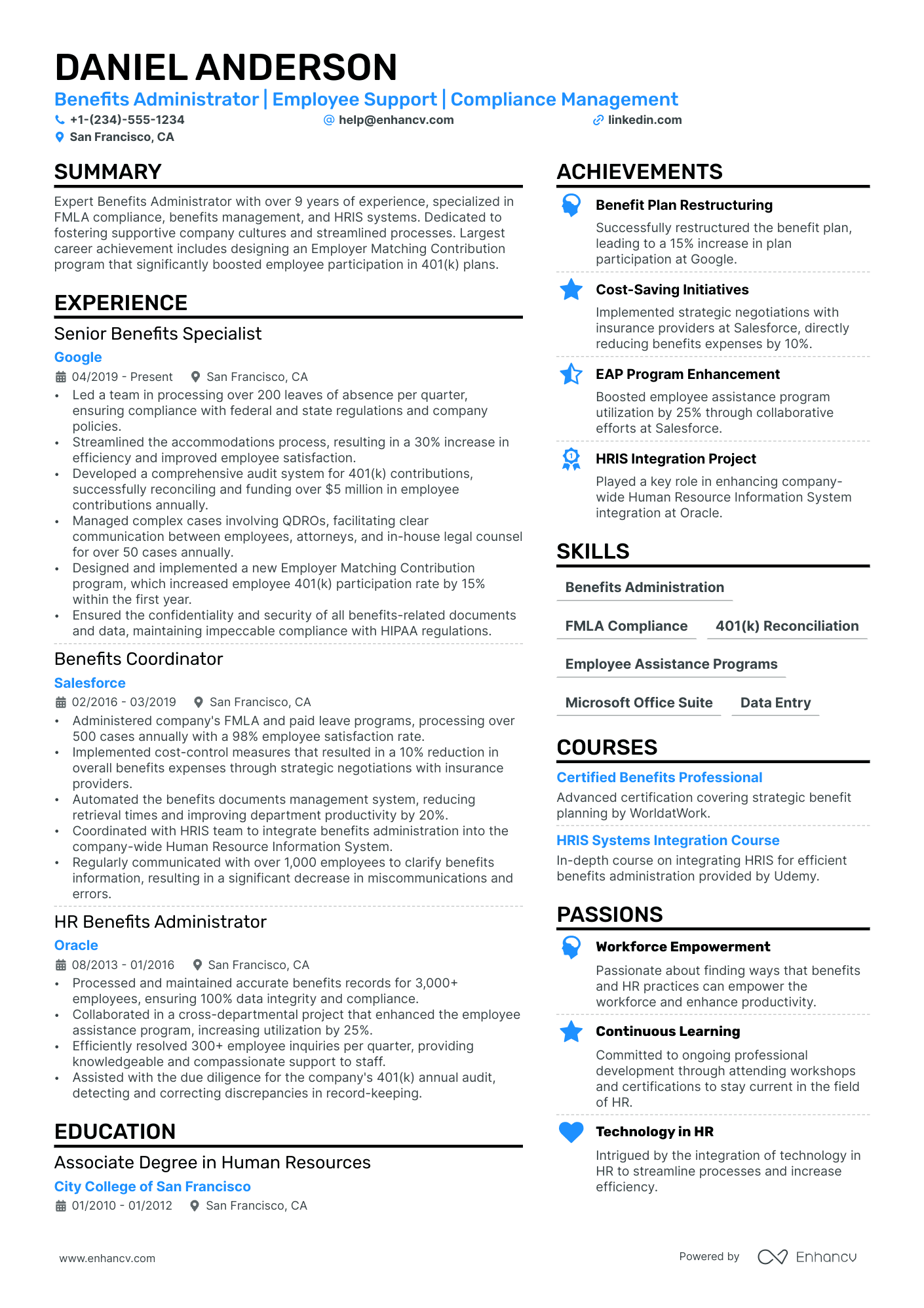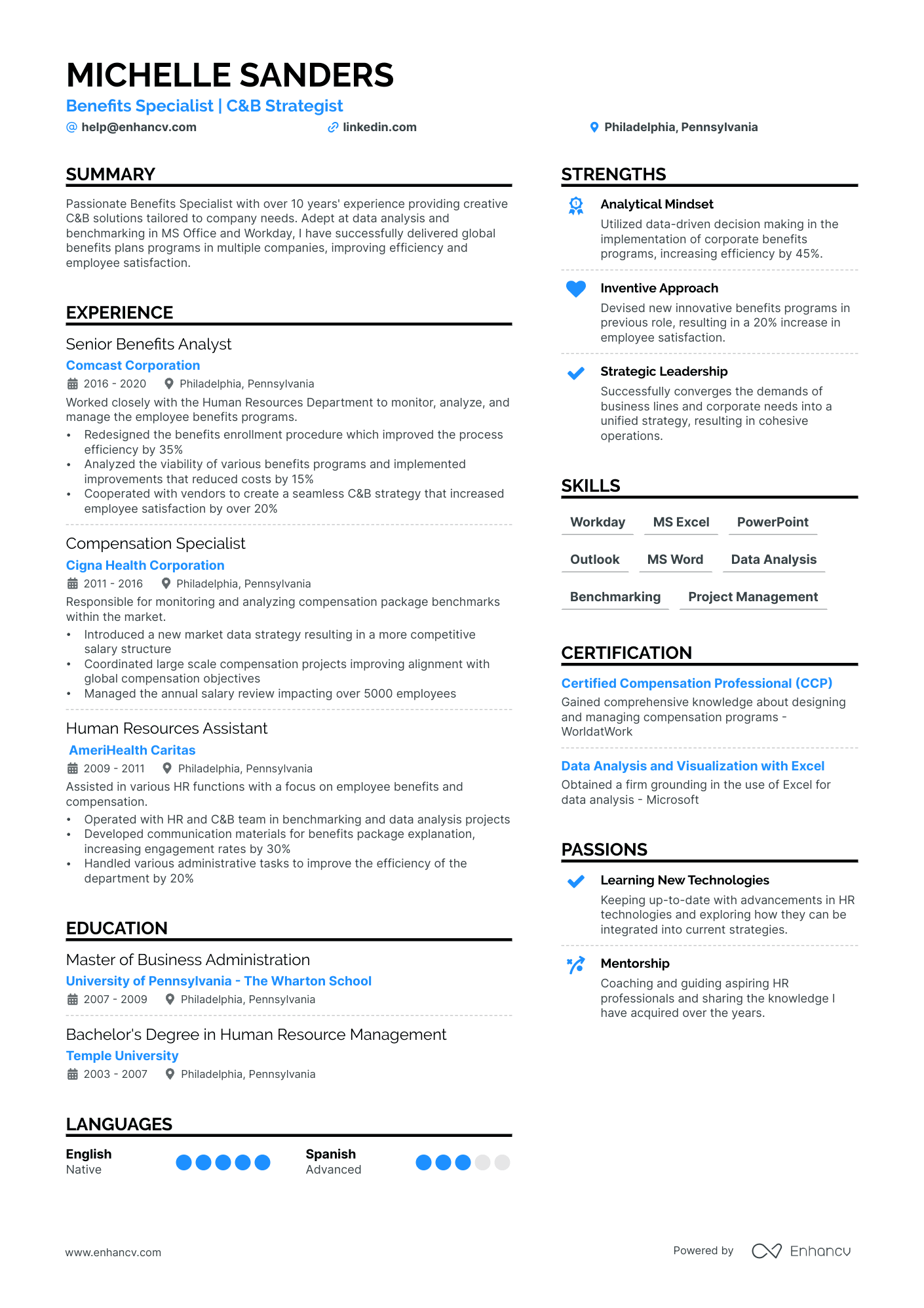As a benefits manager, effectively showcasing your unique blend of human resources expertise and strategic planning skills on a resume can be a daunting challenge. Our comprehensive guide is designed to aid you in articulating your specialized experience and qualifications, ensuring you stand out in a competitive job market.
- Sample industry-leading professional resumes for inspiration and benefits manager resume-writing know-how.
- Focus recruiters' attention on what matters most - your unique experience, achievements, and skills.
- Write various resume sections to ensure you meet at least 95% of all job requirements.
- Balance your benefits manager technical expertise with personality to stand out amongst candidates.
If the benefits manager resume isn't the right one for you, take a look at other related guides we have:
- Transition Manager Resume Example
- Problem Manager Resume Example
- Contract Analyst Resume Example
- Recruiting Coordinator Resume Example
- HR Project Manager Resume Example
- Continuous Improvement Manager Resume Example
- Staffing Manager Resume Example
- Talent Acquisition Manager Resume Example
- Training Manager Resume Example
- Training Director Resume Example
Creating the best benefits manager resume format: four simple steps
The most appropriate benefits manager resume format is defined by precision and a systematic approach. What is more, it should reflect upon how your application will be assessed by recruiters. That is why we've gathered four of the most vital elements to keep in mind when designing your resume:
- It's all about presenting how your experience or skills align with the job. Use the reverse-chronological resume format , if your expertise is relevant to the benefits manager role. Otherwise, select the functional skill-based resume format or the hybrid resume format to shift the focus to your skill set.
- Resume header - make sure you've filled out all relevant (and correct) information, like your contact details and link to your portfolio.
- Resume length - unless you've over a decade of applicable expertise in the field, stick with a one-page resume format. If you'd like to present more of your professional experience, go up to two pages.
- Resume file - submit your benefits manager resume in a PDF format to ensure all information stays in the same place.
Upload & Check Your Resume
Drop your resume here or choose a file. PDF & DOCX only. Max 2MB file size.
PRO TIP
List your educational qualifications and certifications in reverse chronological order.
The five (plus) definite sections your resume for a benefits manager job should include are:
- Header with your headline, contact details, and/or a preview of your work
- Summary (or objective) to pinpoint how your success aligns with the role
- Experience with bullets of your most relevant achievements in the field
- Skills to integrate vital job requirements (both technical and personal)
- Your further dedication to the field, showcased via relevant higher education and/or certifications
What recruiters want to see on your resume:
- Experience in designing, implementing, and managing benefits programs (health, dental, vision, retirement, wellness programs etc.)
- Knowledge of benefits legislation and compliance requirements (such as ERISA, COBRA, ACA, FMLA, etc.)
- Strong analytical skills to assess benefits programs and make cost-effective recommendations
- Proficiency with HRIS and benefits administration systems specific to benefits management
- Excellent communication and interpersonal skills to negotiate with vendors and to assist employees with benefits-related inquiries
What to include in the experience section of your benefits manager resume
The resume experience section is perhaps the most important element in your application as it needs to showcase how your current profile matches the job.
While it may take some time to perfect your benefits manager experience section, here are five tips to keep in mind when writing yours:
- Assess the advert to make a list of key requirements and look back on how each of your past jobs answers those;
- Don't just showcase you know a particular skill, instead, you need proof in the form of tangible results (e.g. numbers, percent, etc.);
- It's perfectly fine to leave off experience items that don't bring anything extra to your skill set or application;
- Recruiters want to understand what the particular value is of working with you, so instead of solely featuring technologies, think about including at least one bullet that's focused on your soft skills;
- Take care with wording each bullet to demonstrate what you've achieved, using a particular skill, and an action verb.
The below benefits manager resume examples can help guide you to curate your professional experience, following industry-leading tips and advice.
- Spearheaded the redesign of the total benefits package, which led to an employee satisfaction increase of 25% in subsequent internal surveys.
- Leveraged data analytics to optimize benefits spend, achieving a 10% reduction in costs while maintaining quality of benefits.
- Introduced a new wellness program that increased employee participation by 40% and reduced health insurance claims by 15%.
- Managed vendor relationships to improve benefits offerings, resulting in an improved employee retention rate by 18% over a four-year period.
- Oversaw the successful implementation of a new HRIS system, streamlining benefits management and enrollment processes for 5,000+ employees.
- Coordinated across multiple departments to ensure compliance with changing healthcare laws, mitigating risk and avoiding potential fines.
- Developed a metrics-driven approach to track the ROI of benefit programs, revealing opportunities to improve employee engagement and satisfaction.
- Launched an employee financial planning assistance program, which was utilized by over 60% of the workforce within the first year.
- Facilitated training for HR staff on benefits negotiation and administration, enhancing team efficiency by 30%.
- Negotiated a comprehensive healthcare benefits plan that saved the company $500,000 annually while improving coverage options for employees.
- Created a benefits communication strategy that increased employee understanding of their options and encouraged a higher rate of plan utilization.
- Conducted annual benefits surveys to gauge employee needs and adjusted the benefits suite accordingly for maximum impact and satisfaction.
- Implemented a cutting-edge benefits administration platform to automate enrollments, resulting in 50% less administrative time spent on processes.
- Executed a targeted health benefits education campaign that led to a 35% decrease in unnecessary ER visits among employees.
- Collaborated with finance and legal teams to ensure the employee benefits programs were both cost-effective and compliant with regulatory requirements.
- Led the successful negotiation of a multi-year contract with benefits providers, locking in favorable rates and service levels for the company.
- Designed an award-winning retirement planning program that helped to double employee contributions to their 401(k) plans within two years.
- Piloted a telemedicine service which decreased average employee sick days and enhanced overall productivity.
- Transformed the company’s benefits enrollment process through the introduction of a cloud-based benefits administration platform, leading to a 20% increase in on-time enrollments.
- Initiated a financial wellness program that provided employees with tools and resources for better money management, improving employee retention by 15%.
- Conducted thorough market research to keep the company's benefits offerings competitive within the industry, attracting top talent.
- Increased employee participation in high-deductible health plans by 25% through strategic educational initiatives and incentives.
- Successfully managed the transition of retirement plan providers with zero downtime, maintaining seamless access for all employees.
- Liaised with executive leadership to formulate a benefits strategy aligned with the company's long-term growth plans and objectives.
- Strategically managed the company’s global benefits program, tailoring packages to meet the diverse needs of employees in over 10 countries.
- Led a cross-functional team in the successful launch of a digital benefits fair, leading to increased employee engagement by 80% year-over-year.
- Championed the adoption of mental health resources, reducing average employee stress levels reported on surveys by 30%.
- Developed a company-wide paid parental leave policy that increased female employee retention post-maternity by 22%.
- Collaborated with IT to implement a secure benefits administration portal, enhancing employee experience and data accuracy.
- Managed the benefits program component of mergers and acquisitions, integrating over 2000 employees without disruption to their existing benefits.
Quantifying impact on your resume
- Specify the percentage by which you helped to reduce employee turnover through your benefits initiatives.
- Highlight the exact number of benefits programs you've designed, implemented, or enhanced.
- Mention the dollar amount of savings achieved for the company through benefits vendor negotiations or plan adjustments.
- Illustrate the number of employees you've supported or advised regarding their benefits options.
- Document the year-over-year growth in employee satisfaction scores as a result of benefits improvements.
- Detail the number of benefits policies you've audited or compliance issues you've resolved.
- Quantify the size of the benefits budgets you've managed or contributed to.
- List the number of training sessions or workshops you've led on benefits education.
Action verbs for your benefits manager resume
Lacking relevant benefits manager resume experience?
Learn how to write your benefits manager resume experience in spite of having no real-world (or applicable) experience for the job.
You should:
- Feature relevant projects or publications that could impress recruiters or showcase that you have the basic skill set for the job
- Shift the focus towards your people (communication, organization, etc.) skills to demonstrate that you're a quick learner and can easily adapt to a new environment
- Use the resume objective to not only highlight your accomplishments but also map out how your career plans are perfectly aligned with the company's vision
- Select either the functional-skill-based resume format (that puts the focus on your skills) or the hybrid one (balancing expertise with skills).
Recommended reads:
PRO TIP
List all your relevant higher education degrees within your resume in reverse chronological order (starting with the latest). There are cases when your PhD in a particular field could help you stand apart from other candidates.
Benefits Manager resume skills section: writing about your hard skills and soft skills
Recruiters always care about the skill set you'd bring about to the Benefits Manager role. That's why it's a good idea to curate yours wisely, integrating both hard (or technical) and soft skills. Hard skills are the technology and software you're apt at using - these show your suitability for the technical aspect of the role. They are easy to track via your experience, certifications, and various resume sections. Your soft skills are those personality traits you've gained over time that show how you'd perform in the specific team, etc. Soft skills are more difficult to qualify but are definitely worth it - as they make you stand out and show your adaptability to new environments. How do you build the skills section of your resume? Best practices point that you could:
- Include up to five or six skills in the section as keywords to align with the advert.
- Create a specific technical skills section to highlight your hard skills aptitude.
- Align the culture of the company you're applying to with your soft skills to determine which ones should be more prominent in your skills section.
- Make sure you answer majority of the job requirements that are in the advert within your skills section.
A Benefits Manager's resume requires a specific skill set that balances both industry-specific hard skills with personal, soft skills. Discover the perfect mix for the Benefits Manager role from our list:
Top skills for your benefits manager resume:
Benefits administration
Knowledge of employment laws and regulations
Human Resources Information Systems (HRIS)
Project management
Data analysis
Financial acumen
Knowledge of health insurance and retirement plans
Employee wellness program development
Compliance management
Vendor management
Communication
Leadership
Problem-solving
Negotiation
Organizational
Critical thinking
Teamwork
Adaptability
Empathy
Attention to detail
PRO TIP
If the certificate you've obtained is especially vital for the industry or company, include it as part of your name within the resume headline.
The benefits manager resume sections you may underestimate: certifications and education
Your education and certifications provide insight into both your technical capabilities and personal attributes, such as perseverance. When crafting your benefits manager resume, consider how you present these elements:
- For your higher education degrees, prioritize listing those most relevant to the job or indicative of your academic dedication;
- Include applicable coursework as a stand-in for relevant experience or if it might impress recruiters;
- Include incomplete higher education only if it's pertinent to meeting job requirements;
- If your degree is from a renowned university, mention how often you made the Dean's list to underline academic excellence.
Regarding certifications, it's not necessary to list all of them. Instead, match up to three of your most recent or significant certificates with the technical skills required in the job description.
Below, we've selected some of the top industry certifications that could be vital additions to your benefits manager resume.
The top 5 certifications for your benefits manager resume:
- Senior Professional in Human Resources (SPHR) from HR Certification Institute (HRCI)
- SHRM Senior Certified Professional (SHRM-SCP) from Society for Human Resource Management (SHRM)
- Certified Employee Benefit Specialist (CEBS) from International Foundation of Employee Benefit Plans
- Professional in Human Resources (PHR) from HR Certification Institute (HRCI)
- Certified Benefits Professional (CBP) from WorldatWork
PRO TIP
Showcase any ongoing or recent educational efforts to stay updated in your field.
Recommended reads:
Deciding between a resume summary or objective for your benefits manager role
Understanding the distinction between a resume summary and an objective is crucial for your benefits manager resume.
A resume summary, typically three to five sentences long, offers a concise overview of your career. This is the place to showcase your most pertinent experience, key accomplishments, and skills. It's particularly well-suited for those with professional experience relevant to the job requirements.
In contrast, a resume objective focuses on how you can add value to potential employers. It addresses why they should hire you and outlines your career expectations and learning goals. Therefore, it's ideal for candidates with less experience.
In the following section of our guide, explore how resume summaries and objectives differ through some exemplary industry-specific examples.
Resume summaries for a benefits manager job
- With 8+ years' experience as a dedicated Benefits Manager within the healthcare sector, adept in developing comprehensive benefits packages that improve employee satisfaction. Successfully implemented a wellness program that decreased employee absenteeism by 15% and enhanced overall productivity. Proficient in HRIS and benefits administration, striving to leverage my expertise to ensure optimal employee welfare and adherence to regulatory standards.
- Seasoned Human Resources professional with a decade at a Fortune 500 company, now seeking to transfer my extensive knowledge of recruitment, employee relations, and performance management to a career as a Benefits Manager. My acumen in strategizing competitive benefit plans resulted in a 20% rise in employee retention, equipped with strong negotiation skills and familiarity with ERISA, HIPAA, and COBRA regulations.
- An enthusiastic professional, eager to translate 5 years of experience in financial management and client consulting into a fulfilling career in benefits administration. Highly skilled in data analysis and fiscal planning with a proven track record of optimizing budget efficiency and stakeholder satisfaction. Keen on ensuring sustainable benefits solutions that align with employee needs and organizational goals.
- Former Project Manager with a strong background in IT solutions and process optimization, ready to pivot into Benefits Management, bringing over 7 years of team leadership and strategic planning experience. Praised for exceptional organizational skills and a results-driven focus, I seek to apply my project management expertise to enhance benefit program delivery and employee engagement in a dynamic new setting.
- Eager to embark on a career in Benefits Administration, bringing forth a strong academic background in Human Resources Management and an unwavering commitment to professional growth. Adept in regulatory compliance and possessing a customer-centric mindset, my objective is to contribute to an esteemed team by providing effective benefit solutions and support to foster a thriving workforce.
- As a fresh graduate with a Master's in Human Resources and an ardent desire to apply my knowledge in practical settings, I aim to secure a position as a Benefits Administrator. I am particularly drawn to leveraging my in-depth understanding of benefits design and labor laws to innovate appealing benefits programs that resonate with diverse employee populations and support company values.
Recruiters' favorite additional benefits manager resume sections
When writing your benefits manager resume, you may be thinking to yourself, " Is there anything more I can add on to stand out? ".
Include any of the below four sections you deem relevant, to ensure your benefits manager resume further builds up your professional and personal profile:
Key takeaways
- The logic of your resume presentation should follow your career highlights and alignment with the role;
- Curate information within different sections (e.g. summary, experience, etc.) that helps highlight your strengths;
- Exclude from your resume irrelevant experience items - that way you'd ensure it stays no longer than two pages and is easy to read;
- Dedicate space within the summary, experience, and/or achievements to highlight precisely why you're the best candidate for the role via your previous success;
- Both your technical and people capabilities should also play a crucial role in building up your benefits manager application. Prove your skill set in various resume sections.
Benefits Manager resume examples
Explore additional benefits manager resume samples and guides and see what works for your level of experience or role.
By Role



